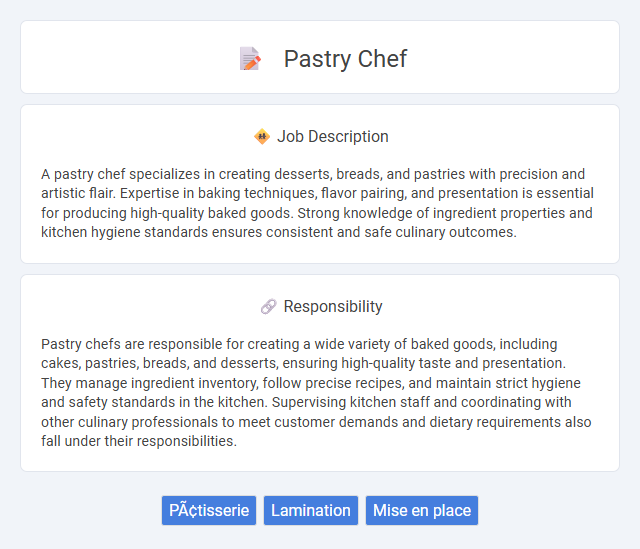
A pastry chef specializes in creating desserts, breads, and pastries with precision and artistic flair. Expertise in baking techniques, flavor pairing, and presentation is essential for producing high-quality baked goods. Strong knowledge of ingredient properties and kitchen hygiene standards ensures consistent and safe culinary outcomes.
Individuals with a strong passion for baking and creativity will likely find a pastry chef role suitable, as it demands precision and attention to detail. Those who can thrive in fast-paced, high-pressure kitchen environments may have a higher probability of success in this profession. Physical stamina is often necessary due to long hours on their feet, making this job potentially less ideal for individuals unable to maintain extended periods of standing or repetitive hand movements.
Qualification
A pastry chef must possess a culinary degree or equivalent professional training, alongside extensive experience in baking and dessert preparation. Proficiency in using specialized kitchen equipment and knowledge of food safety standards are essential qualifications. Strong creativity, attention to detail, and the ability to work under pressure further define a successful pastry chef's skill set.
Responsibility
Pastry chefs are responsible for creating a wide variety of baked goods, including cakes, pastries, breads, and desserts, ensuring high-quality taste and presentation. They manage ingredient inventory, follow precise recipes, and maintain strict hygiene and safety standards in the kitchen. Supervising kitchen staff and coordinating with other culinary professionals to meet customer demands and dietary requirements also fall under their responsibilities.
Benefit
A pastry chef likely enjoys the benefit of creative expression through crafting a variety of desserts and baked goods, allowing for artistic fulfillment. They may also experience job satisfaction from working in dynamic, fast-paced environments that foster skill development and innovation. Opportunities for career advancement and specialization in niche areas such as chocolate artistry or wedding cakes could further enhance the overall benefits of this profession.
Challenge
The role of a pastry chef likely involves navigating intricate recipes that demand precision and creativity under strict time constraints. Challenges often arise from the need to consistently produce visually appealing and flavorful desserts while adapting to seasonal ingredients and customer preferences. Managing the balance between innovation and tradition might be essential for success in this demanding culinary position.
Career Advancement
Pastry chefs can advance their careers by gaining expertise in advanced baking techniques and management skills, often moving from junior positions to head pastry chef roles in high-end restaurants or hotels. Specialized certifications and culinary education enhance opportunities for leadership positions and entrepreneurship, such as opening their own patisseries or consulting for food brands. Networking within the culinary industry and staying updated on industry trends also play crucial roles in career growth and recognition.
Key Terms
Pâtisserie
Specializing as a pastry chef in patisserie requires mastery of delicate techniques such as lamination, tempering chocolate, and sugar artistry to create exquisite French desserts like croissants, eclairs, and tarts. Expertise in ingredient quality, precise measurements, and temperature control is essential for perfect texture and flavor in classic pastries such as mille-feuille and macarons. Proficiency with modern equipment and a deep understanding of flavor pairings drives innovation and consistency within high-end patisseries.
Lamination
A pastry chef specializing in lamination masterfully creates delicate, flaky layers by skillfully folding butter into dough multiple times, ensuring a light and airy texture essential for croissants and puff pastries. Precision in temperature control and dough consistency during lamination is critical to achieving optimal rise and structure. Expertise in lamination techniques significantly enhances flavor development and visual appeal, crucial for high-quality pastry production.
Mise en place
Mastering mise en place is essential for a pastry chef to ensure seamless workflow and precise execution of recipes. This preparation technique involves organizing and measuring ingredients, sharpening tools, and arranging baking equipment before production begins. Efficient mise en place minimizes errors, speeds up baking processes, and maintains consistency in creating delicate pastries and desserts.
 kuljobs.com
kuljobs.com